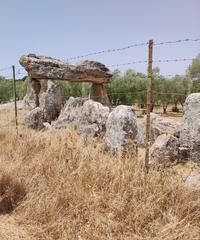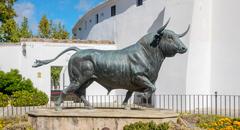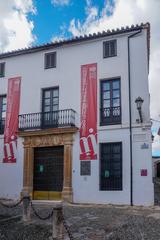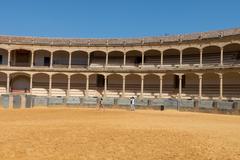Iglesia Mozárabe De Las Cuevas De San Antón: Visiting Hours, Tickets, and Historical Significance in Ronda, Spain
Date: 14/06/2025
Introduction
Dramatically carved into the limestone cliffs above Ronda’s iconic Tajo gorge, the Iglesia Mozárabe de las Cuevas de San Antón—also known as the Ermita Rupestre de la Virgen de la Cabeza—is an extraordinary monument that tells the story of faith, resilience, and cultural adaptation. Dating from the 9th and 10th centuries CE, this Mozarabic cave church is a rare survivor of early Christian communities who preserved their traditions under Muslim rule in Al-Andalus. Today, it stands as both a site of deep historical value and a living center of local devotion, offering visitors a unique journey into Andalusia’s layered past.
This comprehensive guide draws from authoritative sources to provide a detailed overview of the church’s history, architecture, visitor information—including visiting hours, ticketing, accessibility, and nearby attractions—making it an essential resource for anyone planning a visit to this remarkable Ronda landmark (Wikipedia).
Historical and Cultural Background
The Mozárabe Community in Al-Andalus
The Mozárabes were Christian communities living under Islamic rule in the Iberian Peninsula from the 8th to the 15th centuries. While adapting to Arabic language and aspects of Islamic culture, they retained distinct religious practices, notably the Mozarabic Rite, and preserved their faith through periods of tolerance and persecution. Their influence is visible in art, architecture, and liturgy, especially in urban centers like Toledo and Córdoba, as well as rural enclaves such as Ronda.
Origins and Function of the Cave Church
Carved directly into the cliffs, the Ermita Rupestre de la Virgen de la Cabeza provided both a place of worship and a discreet refuge for Christians during times when open practice of their faith was restricted. Its rock-cut construction reflects both practical needs—protection and concealment—and a continuation of earlier Visigothic and Christian traditions of cave worship. The church’s triple-apsed sanctuary, monastic cells, and agricultural spaces exemplify the adaptability and self-sufficiency of its inhabitants.
Ongoing Cultural Importance
The site is not just a historical relic; it remains a living part of Ronda’s spiritual landscape. The annual Romería de la Virgen de la Cabeza draws locals and pilgrims, reinforcing centuries-old traditions and community bonds.
Architectural Features and Layout
Unique Rock-Cut Design
- Sanctuary and Naves: The church features a triple-apsed sanctuary, central and lateral naves, and a crypt. This layout, rare in southern Spain, is a hallmark of Mozarabic architecture and echoes other cave churches such as Bobastro (ronda.ws).
- Monastic and Domestic Quarters: Adjoining the sanctuary are austere cells, thought to have housed a small monastic community, and agricultural spaces including a silo, stable, and wine press, highlighting the inhabitants’ self-sufficiency (info.turismoderonda.es).
- Baroque Chapel: In the post-medieval period, a Baroque chapel was added, now the focus of modern religious celebrations.
Symbolism and Adaptation
Architectural details such as horseshoe arches and burial niches blend Visigothic, Byzantine, and Islamic influences. The adaptation of natural caves for religious use showcases both spiritual symbolism and practical ingenuity.
Preservation and Community Stewardship
Restoration Efforts
After periods of neglect, restoration led by Ronda’s city council and local organizations stabilized the structure, conserved key features, and improved visitor access (Wikipedia). Unlike heavily commercialized caves such as Nerja, the Ronda hermitage prioritizes religious function and historical authenticity (Piccavey, Andalucia360Travel).
Community and Sustainable Tourism
The Hermandad de la Virgen de la Cabeza (Brotherhood) manages the sanctuary, organizing annual festivities and guided visits. Sustainable tourism practices, such as limiting visitor numbers during events, help protect the site’s delicate environment and preserve its spiritual atmosphere.
Visiting Information
Location and Access
- Address: Calle Virgen de los Remedios, 75, 29400 Ronda, Málaga, Spain
- How to Get There: A 15-minute walk from Ronda’s city center, crossing the Puente Nuevo or Puente Viejo. Limited parking is available; local buses and taxis offer convenient alternatives (casacandelaronda.com).
Visiting Hours
- The site does not have fixed public opening hours. Access is managed by the local brotherhood and may vary due to religious events or maintenance. Advance arrangements are highly recommended—contact via email ([email protected]), phone (+34 665 011 224), or WhatsApp.
- During festivals (notably the Romería de la Virgen de la Cabeza in May/June), access may be restricted or require special arrangements.
Tickets and Donations
- No fixed entrance fee—entry is generally free, but donations are encouraged to support preservation.
- Guided tours (often in Spanish, English by prior request) may require advance booking and a modest fee.
Accessibility
- The cave’s rocky terrain and narrow passages pose challenges for those with reduced mobility. There are steps, uneven surfaces, and limited handrails.
- Contact the sanctuary in advance to discuss possible accommodations.
Visitor Experience and Practical Tips
- Preparation: Wear sturdy footwear and bring a flashlight for dimly lit areas.
- Guided Tours: Enrich your visit by booking a tour with local experts or brotherhood members.
- Best Times to Visit: Spring (March–May) and autumn (September–November) offer the most comfortable weather. Early mornings or late afternoons are ideal for avoiding crowds and capturing the best photos.
- Safety and Preservation: Do not touch carvings or altars; supervise children; follow all site rules.
Amenities and Nearby Attractions
- Onsite facilities are minimal; use amenities in central Ronda.
- Combine your visit with other Ronda highlights: Puente Nuevo, Arab Baths, Plaza de Toros, and the picturesque white villages nearby.
Frequently Asked Questions (FAQ)
Q: Are there entrance fees for the Iglesia Mozárabe de las Cuevas de San Antón?
A: Entry is typically free; donations are appreciated to support site maintenance.
Q: What are the visiting hours?
A: The site has no fixed opening hours; visits should be arranged in advance through the sanctuary.
Q: Is the site accessible for people with disabilities?
A: Accessibility is limited due to uneven terrain and steps; contact ahead to discuss options.
Q: Are guided tours available in English?
A: Yes, with advance booking.
Q: When is the best time to visit?
A: Spring and autumn, especially mornings or late afternoons, are ideal.
Comparative and Regional Significance
The Iglesia Mozárabe de las Cuevas de San Antón is exceptional among Mozarabic and cave churches for its southern location, continuous use, and integration of religious, domestic, and agricultural spaces. Unlike the tourist-focused Cuevas de Nerja or Cueva del Tesoro, it retains a living, spiritual character and strong community ties (Wikipedia, Andalucia360Travel).
Travel Tips and Summary
- Plan ahead: Contact the sanctuary before visiting; book guided tours if possible.
- Dress appropriately: Wear sturdy shoes and bring a light jacket and flashlight.
- Respect the site: Follow all guidelines to preserve the church’s unique heritage.
- Explore more: Take the opportunity to visit other Ronda historical sites for a fuller experience.
Visuals and Further Resources
- For images, maps, and virtual tours, see the official sanctuary page.
- Alt-text for images: “Iglesia Mozárabe de las Cuevas de San Antón visiting hours,” “Ronda historical sites,” “Interior of Mozarabic cave church.”
- For up-to-date information, consult Ronda tourism and local guides.
Sources
- Ermita Rupestre de la Virgen de la Cabeza (Official Ronda Tourism)
- Monumentos de Ronda: Ermita de la Virgen de la Cabeza
- Santuario de la Virgen de la Cabeza y Cuevas de San Antón
- Ermita mozárabe de la Virgen de la Cabeza (Wikipedia)
- Piccavey: Caves of Andalusia
- Andalucia360Travel: Caves of Andalucía
For up-to-date guides, downloadable maps, and audio tours, download the Audiala app and follow us on social media for the latest on Ronda’s rich cultural sites.



